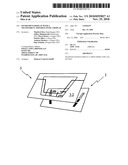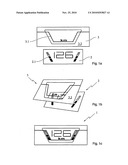Patent application title: INSTRUMENT-DISPLAY WITH A TRANSPARENT APPLIQUE OVER A DISPLAY
Inventors:
Manfred Süss (Remchingen, DE)
Manfred Süss (Remchingen, DE)
Manfred Süss (Remchingen, DE)
Manfred Süss (Remchingen, DE)
Joffrey Ringenwald (Strasbourg, FR)
Pierre Henry (Cologne, DE)
Patrick Alliot (Le Pecq, FR)
Andreas Deubzer (Cologne, DE)
Ingo Schmitz (Konigswinter, DE)
IPC8 Class: AG09F2104FI
USPC Class:
40593
Class name: Signs automotive vehicle carried interior mounted
Publication date: 2010-11-25
Patent application number: 20100293827
ates to a vehicle-display with a carrier-layer.Claims:
1. Vehicle-display (1) with a carrier-layer (2), that comprises
graphic-elements (2.1), characterized in, that an applique (3) is
attached to the carrier-layer.
2. Vehicle-display (1) according to claim 1, characterized in, that the applique (3) comprises a graphic-element (3.1).
3. Vehicle-display (1) according to claim 1, characterized in, that the applique (3) comprises an opaque region (3.2).
4. Vehicle-display (1) according to claims 2, characterized in, that the applique is transparent and the graphic-elements (3.1) and/or the opaque regions (3.2) are applied to, preferably printed and/or etched on, the applique.
5. Vehicle-display (1) according to claim 1, characterized in, that the applique (3) is a film.
6. Vehicle-display (1) according to claim 5, characterized in, that the film has an adhesive-layer.
7. Vehicle-display (1) according to one claim 1, characterized in, that the applique (3) is congruent with the carrier-layer (2).Description:
CROSS REFERENCE TO RELATED APPLICATION
[0001]This application claims the benefit and priority from European Patent Application 08021803.5, filed Dec. 16, 2008, which is incorporated herein by reference in its entirety.
[0002]The present invention relates to a vehicle-display with a carrier-layer.
[0003]Such instrument-displays are well known in the state of the art and display for example the velocity of the vehicle, the temperature of the motor, the rotational speed of the motor and/or warning--or status signals of the vehicle. In most cases, the instrument display is a cluster of various displays. Especially with cluster displays, compromises had to be done regarding the display-quality of the various instruments.
[0004]It is therefore the problem of the present application to improve the quality of the various displays, the flexibility of the display cluster and to produce the inventive vehicle display as cost effective as possible.
[0005]The problem is solved with a vehicle-display with a carrier-layer, which comprises graphic-elements, whereas an applique is attached to the carrier-layer.
[0006]The present invention is related to a vehicle-display, which comprises a carrier-layer. This carrier-layer is preferably a thin plate or a film, more preferably made of a transparent material. The carrier-layer has enough mechanical stability to avoid deformation and/or destruction. However, it is desirable to design the carrier-layer as thin as possible. The carrier-layer comprises preferably graphical elements which are applied, preferably printed or edged, on the carrier layer. The graphic elements can be, for example, a scale, a geometrical element, a letter, a number and/or a symbol.
[0007]According to the present an applique is attached, preferably glued, on the carrier-layer, either on the side adjacent to the vehicle-occupants and/or on the reverse side. Preferably, the applique comprises a graphic-element. This graphic-element can be a supplement to the graphic-element displayed on the carrier-layer or an additional graphic-element. The graphic elements can be, for example, a scale, a geometrical element, a letter, a number and/or a symbol. Preferably, the applique comprises an opaque region.
[0008]Preferably, the applique itself is transparent and the graphic-elements and/or the opaque region are applied to, preferably printed and/or edged, on the applique.
[0009]Preferably, the applique is a, preferably transparent, film which more preferably comprises an adhesive layer. The adhesive layer allows to glue the applique on the carrier-layer.
[0010]Even more preferably, the applique is, at least essentially, congruent with the carrier-layer. Thus, no processing, like for example cutting, needs to be done to the applique after the graphic-elements or the opaque region have been applied to the applique and/or prior to gluing the applique to the carrier-layer.
[0011]The invention is now explained according to FIGS. 1a to 1c. These explanations do not limit the scope of protection.
[0012]FIG. 1a shows the carrier-layer and the applique.
[0013]FIG. 1b shows the attachment of the applique to the carrier-layer.
[0014]FIG. 1c shows the inventive vehicle-display.
[0015]FIG. 1a shows the carrier-layer to which is in the present case a layer 2, which has enough mechanical stability to function as a display in a vehicle, so that it is not deformed and/or does not break. The carrier-layer can be either a thin plate of a relatively thick film. On this carrier-layer two graphical elements are printed, in the present case two bars and a display of a number, in the present case "126", which could be the velocity of the vehicle. Furthermore FIG. 1a shows the applique 3, which comprises also graphic-elements 3.1, in the present case a rhomb and the letters "km" for kilometer. The rhomb is surrounded by an opaque region 3.2. The applique has the same width and the height as the carrier-display 2 below. Thus, the applique 3 and the carrier-layer 2 are congruent and no cutting needs to be done prior to gluing the applique to the carrier-layer.
[0016]FIG. 1b shows the attachment of the applique 3 to the carrier-layer 2. Since those elements 2.3 have the same size, the appliance of the applique to the carrier-layer 2 is very simple. In the present case the applique 3 is a thin film, that comprises on its down-side, which is adjacent to the carrier-layer, an adhesive layer. Prior to the attachment of the applique 3 to the carrier-layer 2, a protective layer (not depicted), which covers the adhesive layer is removed from the applique prior to its application to the carrier-layer.
[0017]FIG. 1c shows the inventive vehicle-display, which comprises in the present case the carrier-layer 2 and the applique 3. The person skilled in the art understands, that the inventive vehicle display can comprise more than one carrier-layer and/or more than one applique.
LIST OF REFERENCE SIGNS
[0018]1 vehicle-display [0019]2 carrier-layer [0020]2.1 graphic element, opaque region [0021]3 applique [0022]3.1 graphic element [0023]3.2 opaque region
Claims:
1. Vehicle-display (1) with a carrier-layer (2), that comprises
graphic-elements (2.1), characterized in, that an applique (3) is
attached to the carrier-layer.
2. Vehicle-display (1) according to claim 1, characterized in, that the applique (3) comprises a graphic-element (3.1).
3. Vehicle-display (1) according to claim 1, characterized in, that the applique (3) comprises an opaque region (3.2).
4. Vehicle-display (1) according to claims 2, characterized in, that the applique is transparent and the graphic-elements (3.1) and/or the opaque regions (3.2) are applied to, preferably printed and/or etched on, the applique.
5. Vehicle-display (1) according to claim 1, characterized in, that the applique (3) is a film.
6. Vehicle-display (1) according to claim 5, characterized in, that the film has an adhesive-layer.
7. Vehicle-display (1) according to one claim 1, characterized in, that the applique (3) is congruent with the carrier-layer (2).
Description:
CROSS REFERENCE TO RELATED APPLICATION
[0001]This application claims the benefit and priority from European Patent Application 08021803.5, filed Dec. 16, 2008, which is incorporated herein by reference in its entirety.
[0002]The present invention relates to a vehicle-display with a carrier-layer.
[0003]Such instrument-displays are well known in the state of the art and display for example the velocity of the vehicle, the temperature of the motor, the rotational speed of the motor and/or warning--or status signals of the vehicle. In most cases, the instrument display is a cluster of various displays. Especially with cluster displays, compromises had to be done regarding the display-quality of the various instruments.
[0004]It is therefore the problem of the present application to improve the quality of the various displays, the flexibility of the display cluster and to produce the inventive vehicle display as cost effective as possible.
[0005]The problem is solved with a vehicle-display with a carrier-layer, which comprises graphic-elements, whereas an applique is attached to the carrier-layer.
[0006]The present invention is related to a vehicle-display, which comprises a carrier-layer. This carrier-layer is preferably a thin plate or a film, more preferably made of a transparent material. The carrier-layer has enough mechanical stability to avoid deformation and/or destruction. However, it is desirable to design the carrier-layer as thin as possible. The carrier-layer comprises preferably graphical elements which are applied, preferably printed or edged, on the carrier layer. The graphic elements can be, for example, a scale, a geometrical element, a letter, a number and/or a symbol.
[0007]According to the present an applique is attached, preferably glued, on the carrier-layer, either on the side adjacent to the vehicle-occupants and/or on the reverse side. Preferably, the applique comprises a graphic-element. This graphic-element can be a supplement to the graphic-element displayed on the carrier-layer or an additional graphic-element. The graphic elements can be, for example, a scale, a geometrical element, a letter, a number and/or a symbol. Preferably, the applique comprises an opaque region.
[0008]Preferably, the applique itself is transparent and the graphic-elements and/or the opaque region are applied to, preferably printed and/or edged, on the applique.
[0009]Preferably, the applique is a, preferably transparent, film which more preferably comprises an adhesive layer. The adhesive layer allows to glue the applique on the carrier-layer.
[0010]Even more preferably, the applique is, at least essentially, congruent with the carrier-layer. Thus, no processing, like for example cutting, needs to be done to the applique after the graphic-elements or the opaque region have been applied to the applique and/or prior to gluing the applique to the carrier-layer.
[0011]The invention is now explained according to FIGS. 1a to 1c. These explanations do not limit the scope of protection.
[0012]FIG. 1a shows the carrier-layer and the applique.
[0013]FIG. 1b shows the attachment of the applique to the carrier-layer.
[0014]FIG. 1c shows the inventive vehicle-display.
[0015]FIG. 1a shows the carrier-layer to which is in the present case a layer 2, which has enough mechanical stability to function as a display in a vehicle, so that it is not deformed and/or does not break. The carrier-layer can be either a thin plate of a relatively thick film. On this carrier-layer two graphical elements are printed, in the present case two bars and a display of a number, in the present case "126", which could be the velocity of the vehicle. Furthermore FIG. 1a shows the applique 3, which comprises also graphic-elements 3.1, in the present case a rhomb and the letters "km" for kilometer. The rhomb is surrounded by an opaque region 3.2. The applique has the same width and the height as the carrier-display 2 below. Thus, the applique 3 and the carrier-layer 2 are congruent and no cutting needs to be done prior to gluing the applique to the carrier-layer.
[0016]FIG. 1b shows the attachment of the applique 3 to the carrier-layer 2. Since those elements 2.3 have the same size, the appliance of the applique to the carrier-layer 2 is very simple. In the present case the applique 3 is a thin film, that comprises on its down-side, which is adjacent to the carrier-layer, an adhesive layer. Prior to the attachment of the applique 3 to the carrier-layer 2, a protective layer (not depicted), which covers the adhesive layer is removed from the applique prior to its application to the carrier-layer.
[0017]FIG. 1c shows the inventive vehicle-display, which comprises in the present case the carrier-layer 2 and the applique 3. The person skilled in the art understands, that the inventive vehicle display can comprise more than one carrier-layer and/or more than one applique.
LIST OF REFERENCE SIGNS
[0018]1 vehicle-display [0019]2 carrier-layer [0020]2.1 graphic element, opaque region [0021]3 applique [0022]3.1 graphic element [0023]3.2 opaque region
User Contributions:
Comment about this patent or add new information about this topic:


